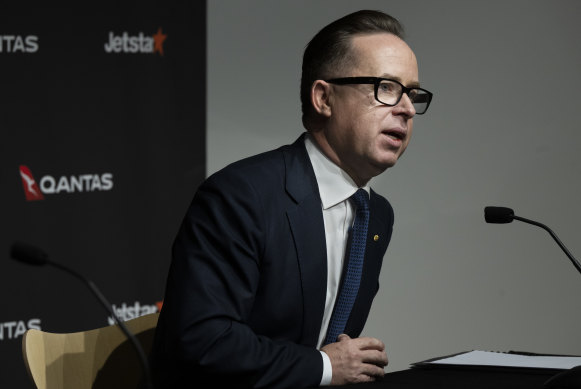Revenge travel: Qantas in $1.4b sweet spot as people suck up high fares
Something about the economics of aviation doesn’t add up. Qantas boss Alan Joyce declares he is dealing with more competition than most other airlines in the world, but the airfares Qantas has been charging are high, in some cases exorbitant.
The record $1.4 billion profit on a 222 per cent rise in revenue for the half year to December – a $2.7 billion turnaround from this time last year – is a direct result of Qantas’ ability to hit passengers with hefty fares. Why? Because it can.

Sure, fuel costs are high and, like all other businesses, Qantas has experienced inflation, but the difference is it was able to pass these on in higher airfares. The huge profit increase also reflects the airline’s success in reducing costs during the leaner COVID years.
Over the past year, passengers have moved from fury about the level of service provided by the airline – its on-time and flight cancellation rates have been poor of late and complaints of lost baggage common – to anger about its elevated fares.
The serendipitous outcome of fixing the service performance was that Qantas legitimately cut back capacity. This manoeuvre wasn’t confined to Qantas; its major competitor Virgin employed the same strategy.
In restraining supply while demand was growing, the two major domestic airlines were able to increase prices – or yields.
In the post-COVID travel-starved market, demand for air travel has bounced back to the point where many passengers are prepared to swallow the higher cost of a holiday.
The aviation industry is definitely in an earnings sweet spot.
There are plenty of people fuming over the prices, but at this point they are still flying.
It will be a while before the supply of international seats, in particular, is sufficient to meet this demand.
Joyce’s evidence for the level of competition is that more than 50 airlines service Australia. But many are also not back to pre-COVID levels.
Qantas says twice as many people intend to travel domestically in the next year compared with pre-COVID, while 60 per cent more plan to travel internationally.
While Joyce promises that airfares will come down over the course of the year, the angle of that trajectory will be determined by how quickly overall group capacity is restored.
For the Qantas group, this will not happen until 2025 under the current schedule.
There are plenty of people fuming over the prices, but at this point they are still flying.
While there are fare discounts and regular sales, the really cheap fares are found mainly in Jetstar.
Qantas mainline knows its customer intimately, thanks to its Frequent Flyer rewards program, and understands that the group is disproportionately affluent and has the means to pay top dollar for tickets and is prepared to pay Qantas a premium.
Joyce maintains that Qantas’ research shows that, despite the cost-of-living squeeze being felt across Australian households and higher rates of interest, Qantas travellers will forgo other discretionary spending to have an experience such as air travel. He said they will cut down on pleasures, such as alcohol and home goods, to take a holiday.
If his research pans out, Qantas shareholders can look forward to at least another year of record earnings.
Virgin is banking on the same outpaced growth in demand to continue, as its owner Bain Capital readies to sell down its stake and return Virgin to list on the stock exchange.
Customers may be miffed about higher fares, but shareholders will be overjoyed that Joyce has announced the second share buyback in a year. This time Qantas will buy back up to $500 million of shares.
Most Viewed in Business
Source: Thanks smh.com